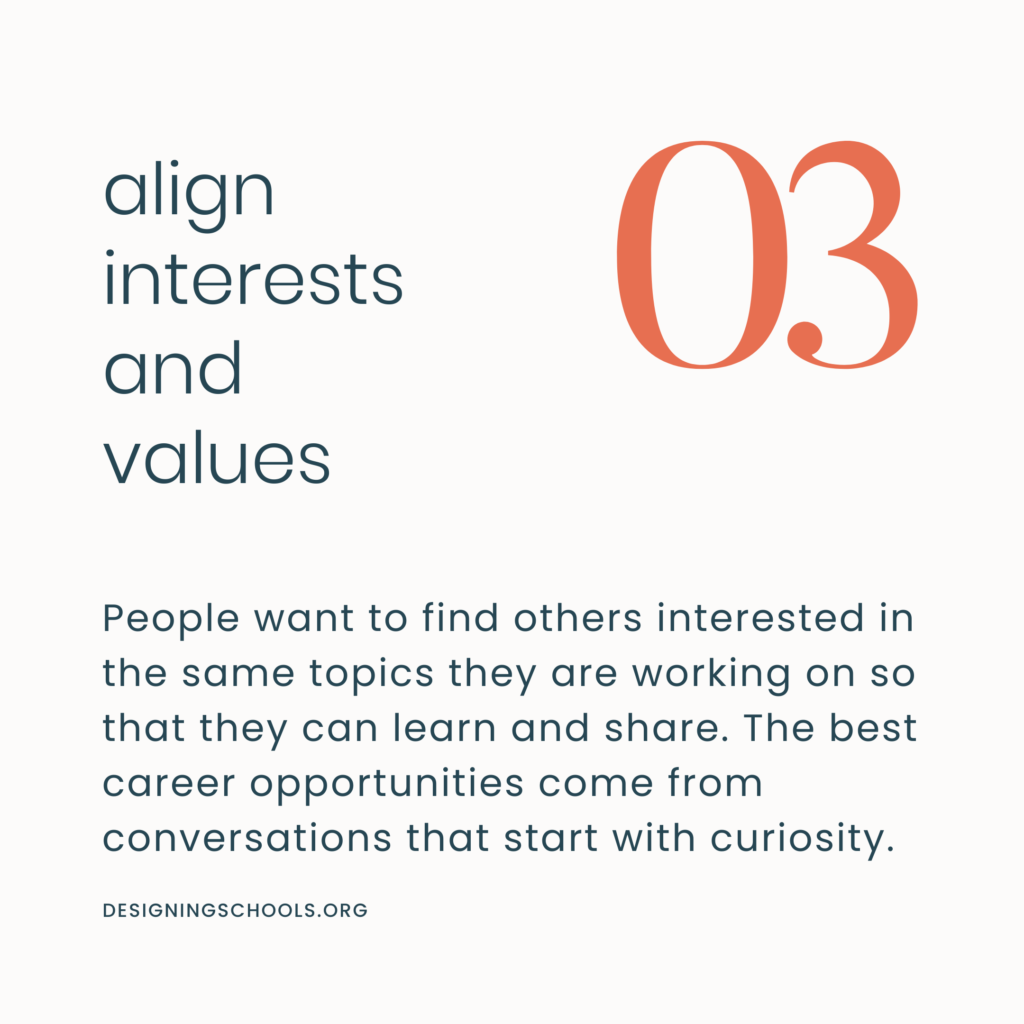Earlier this month I was invited to Mexico City to be part of a keynote panel at IAEA (International Association for Education Assessment) alongside Vriti Saraf and Giancarlo Brotto. All three of us were invited by Lorena Garelli.
All three of us met her during a weekly Clubhouse session we hosted back in 2021. If you’re not familiar with Clubhouse, it was an audio-only social platform that launched during the pandemic and became very popular when everyone was stuck at home.
When people at the conference learned how we met one another many asked for strategies for how to better network online. The curiosities varied from, “I’m an introvert,” to “I don’t really know how to use LinkedIn effectively.”
As adults, especially in today’s turbulent economy, we’re all curious about what other opportunities exist, and how we can access them. Not only is having a professional brand presence an incredible way to learn and meet people. It’s also an investment strategy in yourself for if or when you want to take a different career direction.
If networking in the traditional sense is not something you enjoy, or something you don’t have access to, I’m going to share why you should consider networking through content creation using LinkedIn.
Networking through content creation is a powerful and underutilized strategy. However for many, creating and sharing content online can feel intimidating and overwhelming given the number of platforms that exist today.
3 Ways to Build Your Confidence and Overcome Your Fear of Networking
In this post I’m going to share the best social platform to invest your time when building a professional online presence. And three strategies anyone can use to enhance and develop their networking skills through content creation.
Where Should I Begin Building a Professional Online Presence to Network?
LinkedIn. That’s the one word answer. Now let me share why.
It’s an essential home base for your presence. Any Google search for someone’s name will usually prompt the first link as LinkedIn. I particularly appreciate that it does not make you a slave to an algorithm by mandating the type of content you create. Rather, LinkedIn encourages content creation through a variety of formats including comments.
Ultimately LinkedIn wants you to create and be part of conversations that are shaping the world of work to empower people to learn, share, and grow. As a result your opportunity to engage with existing audiences, and build relationships with new people is exponential.
How Can Networking Through Content Creation Make a Difference to My Career?
Getting hired by a company, finding clients, or being accepted into a college is about getting noticed. Great content, with your unique thoughts and opinions will pave the path to meeting others interested in your ideas. I want to note that these people are not always directly connected to your field.
Each week I write an article for my blog that I cross post on LinkedIn, Twitter, and Instagram. By far my reach, relationships, and conversations that lead to me being hired for opportunities are exponential on LinkedIn compared to other platforms. For many, creating content can feel intimidating. It’s another reason why I use LinkedIn because comments count as content.
Here’s an example of how powerful a comment can be:

In 2018 while doing a research study on design thinking and education, I commented on a post about design sprints. A few moments later I received a connection request from Jay Malone, CEO of New Haircut who has worked with Google, Rosetta Stone and many others on launching innovation initiatives.
One comment on a post, led to a conversation with Jay. And that led to an invitation to the invite-only Google Design Sprint Conference.
Let me say that again. It started with a comment.
At this conference I had the opportunity to learn from Google about how they are using design thinking and design sprints to lead innovation with the world’s top businesses. It was transformational to my research, my own practice, and the work I do with schools today.

P.S. In November I’m hosting a free workshop on LinkedIn about how to create a profile that sparks conversations. If you want to be notified when it goes live click here and let me know.
In the meantime download my free guide, “The LinkedIn Leader,” to create a profile that sparks curiosity and conversations.
This is one of many experiences I and many others have had on the platform. It’s also a skill I wish I had learned much earlier in life when I was a student instead of midway through my career. It’s why I created an online course for students called, “Design Your Future: How to Figure Out What’s Next.” In this course I teach students how to identify and articulate their skills and strengths, showcase their ideas, projects, and experiences all with LinkedIn.
Every adult when they see the course says, “I need to explore LinkedIn,” and that’s why I’m hosting a free workshop for adults in November. If you want to create and enhance your online professional presence and create a LinkedIn strategy plan for 2023 then click here to sign up to be notified.
Now that you know why LinkedIn, let’s explore three strategies you can use to overcome your fear of networking so you feel more confident in creating conversations with others online and offline.
Networking Strategy #1: Networking is About Learning
Building an online presence and networking is about being a lifelong learner. When you approach meeting people, learning about new ideas and emerging trends, and staying up to date in your field as a learner with curiosity it will not feel like an activity you have to do.
It will be something you enjoy doing.
You also want to approach networking with a growth mindset. Instead of saying things like, networking makes me nervous. Or I’m so not in the mood to attend this event, say I wonder what I might learn today. I wonder how a conversation or post might inspire me in my current work. Not only does this shift your mindset and energy, your brain will be more active in looking for those connections. You also want to remember your first try is never your last try. Never be afraid of hearing no, because if you don’t try you’ll never know.
Networking Strategy #2: Aligning Interests and Values
One of the greatest gifts social platforms have provided is the opportunity for us to meet people beyond our usual proximity. You’ll often hear many say how when they are trying a new idea. Or if they are in a leadership position, that they feel lonely. The internet has allowed people to learn from, share, and collaborate with others beyond their proximity. These connections are often formed from shared interests and values that lead to opportunities. These opportunities are ones that are often created through the content and conversations, not ones that are always found on a job board.
If you remember from the example I shared with you earlier with Jay his message started with a comment about my headline, “Cultures of innovation begin with a culture of empathy.”
Immediately when coming to my page you can learn my philosophy about innovation.
Your headline and about me section are the first places to focus when creating your LinkedIn profile so that you can spark people’s curiosity to learn more about you.
I often recommend two resources for beginning to create these:
- Sparketype – A free assessment that reveals what energizes you at work
- Black Sheep: This book written by Brant Menswar is an incredible guide to thinking through your top five non-negotiable values and how they show up in your life. He has a free assessment you can take on his website.
That one headline paired with the content I share has allowed me to form relationships with people I’ve never met in real life, yet have come to know through our shared beliefs, values, and vision for the future of work in our field. In fact 70% of my invitation to speaking engagements and workshops begin with sentences like these:
“I read your article and….”
“I saw a post where you shared “X” and _____”
This is equally as important for people finding you, and for you to find and connect with people you want to know. For example, when I was making my documentary, which launched last month, “Designing Schools: The Future is a Place We Create,” I dreamed about interviewing Erik Brynjolfsson. I had spent a lot of time watching his YouTube videos, reading his articles, and following him on Twitter. It just so happened that one retweet caught his attention that led to a conversation.
In that conversation because I was so familiar with his work I was able to align my interests to his. I was in education, he was in economics, however there was a shared interest in technology and how it could be used to help people find new ways of working. So the moral of the story – research, research, research, and learn as much as you can about the people you want to know. That way when that moment happens you’re ready.
Networking Strategy #3: Share From Your Lens of Expertise
People often think about networking as what can I get. But when you turn this around and think about what can I share, what contributions can I make, everything changes. One concern I often hear from people is will anyone even care what I have to share. Or so many people are already writing about this, is there room for me?
Another doubt I hear is around age. Never assume that just because you are younger that you have nothing to offer. Or that you are older and don’t have the technology skills to use these platforms. Now more than ever before, learning from individuals in different stages of their career is essential.
I encourage people the next time they are in a gathering, at a meeting, or an event to ask people how many of them have active blogs, LinkedIn, or other social accounts where they are consistently showing up and participating. The answers will surprise you. When we are online it is easy to feel as if the market is saturated. It’s far from it.
There’s a difference between sporadically posting and sharing, and sharing with purpose and strategy. In my free workshop in November, “From Classroom to Creator,” I’m going to share how to plan a 2023 strategy if you’re interested in building a professional online presence and exploring other opportunities with LinkedIn.
Identify Your Strengths
It’s essential to remember that every single person has unique skills, strengths, and experiences. The key is to identify yours and lead from your interests and values. In fact, things that you may think of as incredibly ordinary just because it’s what you do, will be insightful and fascinating to others. Now this might not be an easy list to come up with, because as Derek Sivers says, “What’s obvious to you is amazing to others.”
Now that you know why LinkedIn and ways in which you can use content to network in my next post I’ll share the types of content you can post.
Before you get started with adding people and creating content, remember your first impression is a digital impression. You want to make sure your profile is complete. If you’re wondering what that means, download this guide, “The LinkedIn Leader,” to review the LinkedIn checklist and tips for how to create a profile that sparks curiosity and conversations.




I’m Sabba.
I believe that the future should be designed. Not left to chance.
Over the past decade, using design thinking practices I've helped schools and businesses create a culture of innovation where everyone is empowered to move from idea to impact, to address complex challenges and discover opportunities.
stay connected
designing schools